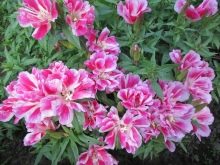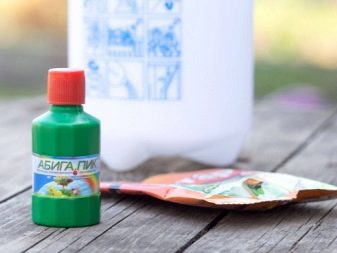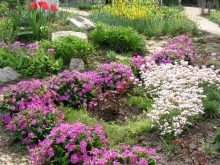Godetia and its cultivation

Godetia can be a very useful and practical crop if you know how to plant it with seeds and seedlings. It is also worth studying the specifics of the subsequent cultivation of a flower in a flower bed, caring for it in the open field and at home. In conclusion, it is advisable to get acquainted with the godetia terry Red wine and other types and varieties.
general description
Godetia is rather from a botanical point of view not a separate genus, but a subgenus in the genus Clarkia, which belongs to the family of fireweed plants and the myrtle-flowering order. About 20 species of godetia are known, which are present in nature mainly in North and South America. Botanical relatives (within the order of the myrtle) can be considered:
- fuchsia;
- fireweed;
- evening primrose;
- Garnet;
- myrtle;
- eucalyptus.

Biologists believe that godetia comes from southern California. The original name of this genus or subgenus was given in honor of the discoverer - botanist Godet from Switzerland. Already in the 1860s, the new plant became very popular in horticulture. His flowers look like they are made of fine silk. Their similarity with azalea flowers is noted. Even in the 21st century, godetia remains a favorite horticultural culture. The plant has a total height of 40 to 60 cm. It has smooth stems with intense branching. The flowers reach a cross section of 6-7 cm, while they have a double or simple type. It is common for these flowers to cluster into lush-looking inflorescences. The brush reaches its maximum elegance, of course, at the peak of flowering.
The buds can be raspberry and white, pink and lilac colors. In some cases, there are pink-purple and variegated varieties. Flowering occurs at the end of July and usually occurs before the onset of frost. Godetia is a typical annual crop, and therefore will have to be renewed annually.... It is characterized by the formation of entire, lancet-like leaves, which are arranged according to the next scheme. The fruit of the godetia is a box with 4 sides. It is visually similar to a box. A large number of seeds are hidden inside the fruit, which do not lose their germination within 2-3 years. Hybrid varieties of godetia are divided into dwarf and high-altitude forms. Towards the end of the vegetative period, the stems become lignified.

Types and varieties
Large-flowered godetia cannot boast of the height of the bushes. It is only from 20 to 40 cm. Both the direct growth of the shoots and the tendency of some of them to creep along the ground are characteristic. The bushes themselves are invariably spreading, have a large number of branches. The foliage has the shape of a lancet or an ellipse, and has a high density. It blooms in July, August and September. Large buds are created on the tops of the shoots. When opened, the flowers reach a section of 10 cm. The flowers themselves are shaped like a bell or a bowl, divided into 4 petals. In the species form, they are single, in the varieties developed later, they have a double or other configuration.
In large-flowered godetia, the inflorescences can be colored in:
- pink;
- White;
- Dark red;
- purple tones.
The lovely godetia has erect tall (up to 60 cm) bushes by default. This species has relatively few branches. The foliage has a narrow lanceolate structure and sharp ends. During flowering, which falls in July, August and September, racemose inflorescences appear.Each such inflorescence contains funnel-like or bowl-like flowers with a cross section of 4 to 5 cm.
In favor of the azalea flower godetia, it is evidenced by its minimal whimsy. This type is great not only for ordinary garden plantings, flower beds in summer cottages, but also for graceful beddings. His large flowers are grouped into dense, shortened brushes. The flowering period starts early and lasts a long time. Terry godetia also deserves attention. It will bloom from June, until the arrival of real frosts. It is worth noting that in nature, terry is not characteristic of this plant. However, it was achieved in a number of hybrid varieties. And also breeders have learned to get semi-double and thick double plants.



Variety Red wine grows up to 40 cm. Flowering breaks off only with the onset of frost. The scarlet-red flowers of this culture reach a section of 5-8 cm. Important: excessive moisture is contraindicated in red wine. The suitability for cultivation for seedlings or for direct planting in the ground is noted. Variety Orange room able to grow up to 40-50 cm. Red-green shoots are typical for him. The flowers are shaped like a wide bell. The red-orange petals look pretty, as do the narrow lancet-shaped leaves. The bushes develop semi-sprawling.
Variety Summer Paradise in height reaches 40-50 cm. Its flowers have a double or semi-double appearance, as well as a significant size. These flowers have wavy edges. The flowering period is in July, August and partly September. The bushes are shaped like a ball. Noteworthy type Sybil Sherwood. It is low, a maximum of 30-40 cm. It is characterized by the appearance of green shoots with a slight pinkish tint. Lanceolate foliage is noted. The section of semi-double flowers can be up to 5 cm.
Godezia Beauty of Summer is an expressive mixture of colors. Such a culture has a compact bushy form. The flowers are shaped like a bowl. Its cross-section will be up to 6 cm.The plant sometimes reaches a height of 60 cm. Cattleya variety much lower - it grows only up to 40-42 cm. Abundant flowering, beginning in July, ends most often in October. A characteristic feature of this variety is the presence of semi-double petals with a wavy edge.
The culture is suitable for decorating plots and subsequent cutting. The cold-resistant plant develops well in sunny places.



Choosing godetia Butterfly, you will have to put up with the fact that it will grow only up to 50 cm. You can expect the emergence of seedlings as early as 14 days after planting. Terry leaves with a wavy perimeter look very attractive. Such a culture can decorate any border.
Slightly lower - Orange Glory, the bushes of which reach 45 cm.Other features of the variety:
- spherical crown;
- bloom in the last 2/3 of the summer;
- unsaturated pink-orange color of flowers;
- "Solar" effect;
- a large number of flowers.
Among other varieties deserve attention:
- Satin;
- Grace;
- Meteor;
- Monarch;
- Crystal snowflake.


Landing
It is quite possible to plant the main types of godetia by seeds. Direct sowing in open land is usually practiced in the southern regions. This technique is simpler and more gentle for the culture itself. This species usually tolerates transplantation very badly, there is a high risk of damaging the seedlings altogether. But in the middle lane, and even more so in the northern regions, there is no choice - there it remains only to plant seedlings according to all the rules.
Sowing in open ground takes place either in May, or before winter (in November). Godetia can easily survive cooling down to –5 degrees. Thanks to this, the planting of the same seedlings in the first ten days of May is not a problem. The seedlings themselves are usually started in March and are closely monitored to adhere to controlled growing conditions. This technique allows you to achieve success by July, and enjoy the plantings until the onset of severe cold weather.
With regard to the quality of the land, open, sunny places are most preferable. They should have moderately moist soils - humus or loamy type. Dry clay soil is not suitable for godetia at all. To improve the quality of the soil, they are preliminarily laid on 1 sq. m:
- 5 kg of compost;
- 0.3 kg of wood ash;
- 60 g nitrophoska.
There are a few more important rules:
- maintain intervals of 20 cm between seedlings;
- transplant seedlings only with a lump of soil (transshipment is more practical);
- pre-harden the seedlings for 2 weeks;
- the organization of the greenhouse effect helps to activate the germination of seeds;
- water the seedlings in a gentle way so that the seeds are not washed away (it is best to use a sprayer).


Growing care
Watering
Irrigation of godetia outdoors is a very important point. And at the same time, it is it that causes the most problems for flower growers. Such an exotic culture categorically does not survive the dry period. Hot days are all the more destructive for her. However, it must be remembered that godetia often suffers from too high moisture in the earth. Therefore, it should be watered sparingly, while maintaining a stable light soil moisture.
Top dressing
In order for godetia seedlings to develop well at home, they should be fed with different frequencies.... The criterion for this frequency is the level of soil fertility. Depending on it, the intervals between dressings are from 14 to 30 days. Important: you should avoid excessive amounts of nitrogen and other nutrients so that the green mass does not develop to the detriment of flowers. A selection of complete mineral complexes adapted for summer and flowering crops is recommended.
Such a plant can only be transplanted at an early stage of development. When it ends, replanting will greatly harm the flowers. Pruning is not necessary, as the godetia itself develops the optimal shape. Usually, just removing the faded inflorescences is enough.
Special formative pruning is carried out as carefully as possible and is not always necessary.

Diseases and pests
Rust and peronosporosis pose a great threat to godetia.... These pathologies are formed due to the activity of pathogenic fungi. The solution to the problem is the use of fungicides in accordance with the instructions. Suppression of root rot is impossible, diseased specimens will have to be completely removed. Infection with such rot is evidenced by the fact that godetia dries and withers, develops slowly, and becomes covered with brown spots. In a neglected state, such a disease is incurable. Prevention is carried out by treatment with fungicides. Peronosporosis is also provoked by pathogenic fungi. The diagnostic symptom is the appearance of slightly convex spots of a vague shape. Such spots are colorless, but they also have a yellowish, violet, yellow-brown or red-brown tone.
In some cases, the perimeter of the spots develops unexpressed border. Faint plaque is found underneath the patchy areas. Sick foliage takes on a wrinkled appearance, can curl and die off, drying out. Another characteristic feature is the shedding of buds, their transformation into ugly flowers, accompanied by spotting of the shoots. Suppression of infection is possible due to treatment with "Abiga-Peak" and "Oxyhom". Instead of these drugs, it is often used "Previkur" or one percent bordeaux solution.
It is worth remembering that the destruction of pathogens from the first call is not always possible. Most often, after 10-15 days, the treatment is repeated. Godetia can also be attacked by leaf-gnawing insects that move from melons. Insecticide treatment and systematic weed control can help reduce the risk of such a problem.


Application in landscape design
Godetia can look great in the neighborhood with other flowers, and in a monoculture bed or on a monotonous lawn. Low-growing variants of the plant are planted on balconies and in yards in pots, and also used in border plantings. High forms of godetia are used in the centers of flower beds and mixborders. Squat decorative cineraria and stachis are most often planted next to them.
Ageratum and lobelia are also good companions. But godetia itself looks really magical. The choice between single and group landings is at your discretion. It is also allowed to design hedges and decorate entrance groups. In addition, it is worth mentioning the use of this culture in rabatkas.










































































































The comment was sent successfully.